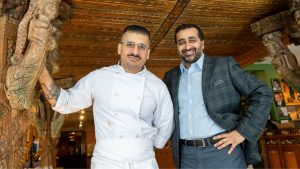Roughly a year after BlackBerry acquired cybersecurity company Cylance in a $US1.4-billion deal – the largest in the company’s history – chief technology officer Charles Eagan was keen to show off the two firms’ combined capabilities at the annual Consumer Electronics Show in Las Vegas this past week.
BlackBerry’s Kanata-based CTO is steering the Waterloo-based tech giant and its local R&D operations towards a fully connected future. Some 10 per cent of vehicles can be considered “connected” today – that is, they communicate with systems outside the vehicle itself – but Eagan says that figure is expected to balloon to 90 per cent in just five years.
“It’s inevitable,” he tells Techopia.
OBJ360 (Sponsored)

What’s happening in Ottawa in 2024? Ottawa Tourism has your activity line-up covered
2024 promises to be another fun-filled year for Ottawans and visitors alike!

Vegan? Halal? Gluten-free? This Ottawa restaurant has you covered
For food lovers who have dietary restrictions, it can often be a challenge to find a restaurant that checks all the boxes.
To prepare the wider company for the connected revolution, Eagan leads a team of 120 people across the firm’s Ottawa, Waterloo and Mississauga offices dubbed “BlackBerry Labs.” The labs unit has its gaze fixed firmly on the horizon: it looks out to the industry for new features that could eventually be bridged into BlackBerry’s product roadmap, whether that be in the company’s burgeoning autonomous vehicle business or its enterprise software division.
Eagan confesses, however, that he doesn’t own a crystal ball. He doesn’t know what the autonomous vehicles and connected cars market will look like five or 10 years down the road.
What he does know, however, is that data and machine learning capabilities will be key to whatever future crystalizes.
Generating driver profiles
That’s, in part, why the Cylance acquisition was worth more than a billion dollars to BlackBerry. At CES, BlackBerry unveiled a series of features powered by the Cylance integration, from early malware detection to regular diagnostic scans of the car body itself.
Many of these new features come down to redefining the notion of “trust,” Eagan explains. In cybersecurity, trust often comes down to a firewall or password – something that, once given, allows a user unfettered and continual access to whatever was behind the gate.
With the Cylance integration, BlackBerry looks to a more dynamic concept of trust. Cylance’s machine learning capabilities can, for example, detect behavioural patterns in driving. A connected car’s internal platform can develop a profile of its owner by learning how an individual drives, for example. If behavioural patterns are different from what the vehicle is trained to trust, it can pull off the road and stop right there – if that’s what it’s programmed to do.
These features could not only prevent an untrusted driver from stealing a vehicle, they could potentially put a stop to incidents of impaired or distracted driving.
While the security element is obvious, Eagan says it’s the data that comes from these machine learning profiles that generates true value. Insurance companies, automakers, fleet managers – if users consent to sharing behavioural information, that data could provide valuable insights for a host of parties.
“Data is the currency of the future. And there’s going to be a lot of data,” Eagan says.
Smartphones a precursor to connected cars
BlackBerry doesn’t intend to prescribe every use case for its automotive platform. Rather, Eagan says the company hopes to create the foundation for an ecosystem of applications surrounding the vehicle.
Eagan, who previously worked on BlackBerry’s BB10 phone system, says the rise of the smartphone is a useful comparison for his vision of the connected car market. Cars are moving from just being a vehicle to being a mobile server of sorts, with internal computing power and connections enabled by 5G networks. In a similar way that the phone evolved into a ubiquitous mobile computer, vehicles will soon be ripe for a host of applications we’ll soon consider “essential.”
“They’re kind of moving from being reptiles into mammals,” Eagan says, hammering home the evolution metaphor. “The automobile will have a similar day that’s not too far out.”
In the heyday of BB10 development in BlackBerry’s Kanata offices, Eagan recalls the halls being lined with student workspaces as the company ramped up its need for engineer talent. With around 500 employees in Kanata today, the firm isn’t quite bursting at the seams – but Eagan does see similar demands on the horizon.
“The empty spaces are shrinking,” he says with a laugh.
He feels confident, however, that the talent pool in Ottawa will keep the company well-stocked in the coming years. Opportunities such as CES, where he can pitch the big picture of BlackBerry’s work in uncharted territories, are increasingly pivotal to selling prospective employees on the company’s journey.
“There’s a lot of opportunities in Ottawa for good engineers. So we have to make sure we sell them on the vision and try to get people that are passionate about it,” Eagan says.





